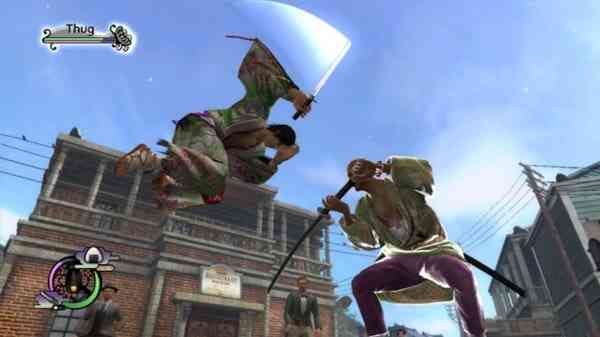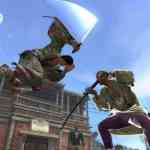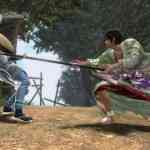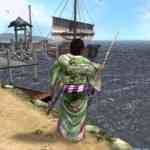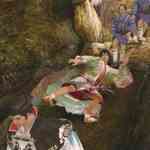Way of the Samurai 4 follows the plot tradition established in previous games in the franchise. You step into feudal Japan as a nameless Samurai, and based on your choices you affect the climate of your village with your sword-for-hire activity. In this case, the setting takes place in the fictional port town of Amihama in 1855. Japan has only recently opened trade with the West, and as a result there is strife and grief. The British Navy has arrived to establish relations with Amihama, but the Disciples of Prajna, an anti-immigration faction, want them out at all costs. It’s up to you to decide if you’ll protect the foreign visitors, join the Disciples to kick them out, or work with the local government to keep the factions apart, by any means necessary.
Way of the Samurai 4 is quite a quirky controlling game. The lack of control is the lowlight here for me. You will find that more than once, okay a thousand times, you will curse the terribly cumbersome control. I kept finding that once you are locked into certain moves it is near impossible to get out of them. You would think that this gaff would open you up to attacks from enemies, but the game moves extremely slow letting you escape unscathed more often than not. Misaiming your attack exacerbates this issue though. Sword thrusts are a major part of the game, but a mistimed and misaimed thrust goes by the enemy. I found that I actually re-adjusted and aimed too far the other way it was almost humorous.
Opportunities to learn new moves and fighting styles are ever present, but the core gameplay is far too slow and awkward to ever resemble anything overly enjoyable. There are many missions that require you to fight off several dozen enemies, and each combatant takes a grueling amount of time to kill. I often reverted to simply standing in a corner and doing a thrust move toward enemies as they came towards me. This ensured me of almost perfect aim (if stood just right) and some time savings were gained. I suppose since everything is so slow you can end up killing most with no issues whatsoever. Even if you are fighting large groups they take you on one at a time. The game almost works as a one-on-one fighter, so it is not only confusing but also boring when you are forced to fight a huge group of weak enemies back to back.
There is a wide variety of fighting styles and skills that you can master throughout the game. Swords can now be switched to any stance and skills, and once learned they are bound to the player. I am particularly fond of a special mode similar to Dead Eye aim in Red Dead Redemption. You enter a slo-mo mode for a limited duration allowing you to slash enemies repeatedly. It is neat to see your on screen persona sheathe his sword and all the dead enemies fall down at the same time. It can be quite effective in certain battles, and looks cool to boot. Sword mechanics include durability points, which will drop gradually with use. Eventually weapons will break. This forces players to visit the blacksmith for repairs and upgrades.
Way of the Samurai 4 has a large number of multiple endings, which in theory is a good thing, but in this case you will be hard pressed to find the gumption to play through repeatedly. The problem with this is that once you make it through the game once, jumping back in feels like a chore. On the positive side, the swords and weapons that you unlock along the way can be carried over to your next play through.
There is an impressive open world for you to explore. During your journeys you have a ton of dialogue choices to get you to your destination, and it takes every opportunity to figure out where you need to go. The game has a humor that is right on the mark, but I found myself laughing for the wrong reasons. Genuinely bizarre and often-comedic situations generated charm, but the dated visuals, control difficulties, and stiff combat takes away from what could have been.
I did like the game’s fairly large customization mode. You can fully customize your character with attributes like age, hair, height, weight, clothes, shoes, and other accessories. I got my character looking like LeeLoo from The Fifth Element, and I must say I had a good laugh while doing it. You can also go the other way making a character that is totally badass clad in black and has a big sword. Truly a fun time as the customization options are neat.
Your health and energy meter is regenerated by life points set at 1000. You regenerate when stationary or moving away in combat, and they deplete when you fight or partake in night-crawls. Food and sleep can regenerate your energy meter, but you must have one or the other in order to utilize them. You can find straw blankets around the towns and have the ability to sleep outdoors.
While the game is bright and colourful, it is rife with issues. One of the first problems I noticed right from the beginning was the awful screen tearing. The tearing is present in almost every area of the game, from the menus, during gameplay, and in the cut scenes. You won’t notice the problems too much during actual gameplay as your focus is naturally elsewhere, but when your enemy warps strangely from head to toe it is hard not to acknowledge the problem. The game’s frame rate takes some real hits too. On top of this, some cut scenes have strange visual artifacts. In an early cut scene, for instance, a background ship has a black line jutting out from its side into infinity. Given the substandard quality of the environments and characters as a whole I can’t help but wonder why so many graphical errors are present. An engine that is as borderline last-gen as Way of the Samurai 4’s really shouldn’t have issues with optimization.
In regards to the game’s audio, the music is quite good, with some very traditional Japanese melodies. Even though the game is cheesy and over the top, the music is beautiful and engaging, and on some levels matched the visuals in certain spots nicely. I’m not going out to find the CD soundtrack, but it really is well done. The game has plenty of voice work, but none that really stands out. That being said I particularly liked the combat scenes where heated banter would flow from both friend and foe. It adds to the distinct flavor of the game overall. Speaking of friend and foe, there is no shortage of clashes throughout the game. Swords clash and clang with copious amounts of blood flow from gaping wounds. Everything is well thought out, but the execution is just a bit off.
Fans of the series probably will enjoy this game almost immediately. Personally I found the game a bit too out there to really enjoy some great ideas. Unfortunately the plodding gameplay is the biggest detractor; it is like waiting for hell to freeze over at times. For those that can look past the issues, the game can open up into a decent hack and slash with fair amount of depth; you just have to invest the time to get there.
